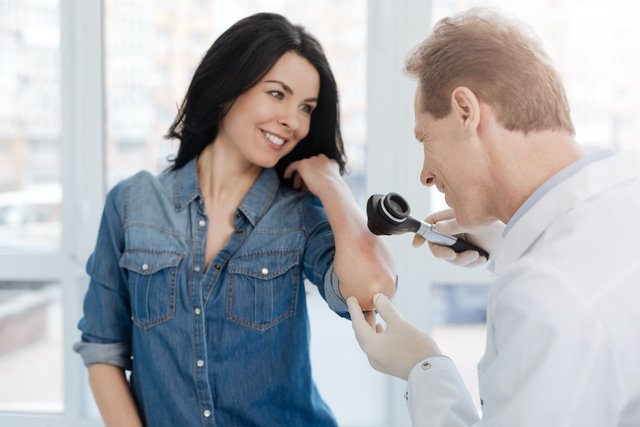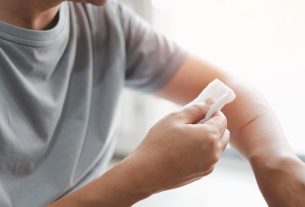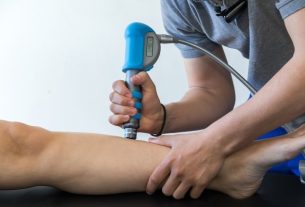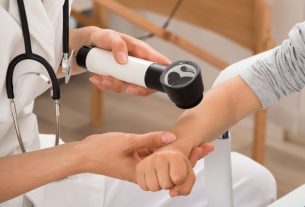Mycosis fungoides is a rare type of cancer that affects the skin, caused by mutations in T cells, a type of white blood cell, which begin to multiply uncontrollably, attacking skin cells, and resulting in symptoms such as red spots or plaques on the skin, itching, thinning of the skin in the affected area or nodules on the skin.
Mycosis fungoides, also known as cutaneous T-cell lymphoma, is more common in people over 50 years of age and in men, but it can also affect anyone at any age.
The treatment of mycosis fungoides must be carried out by a dermatologist, hematologist or oncologist, and varies according to the stage of the disease, and the use of ointments, such as corticosteroids or imiquimod, radiotherapy or chemotherapy, for example, may be indicated.
Sensitive content
This image may contain content that is uncomfortable for some people.
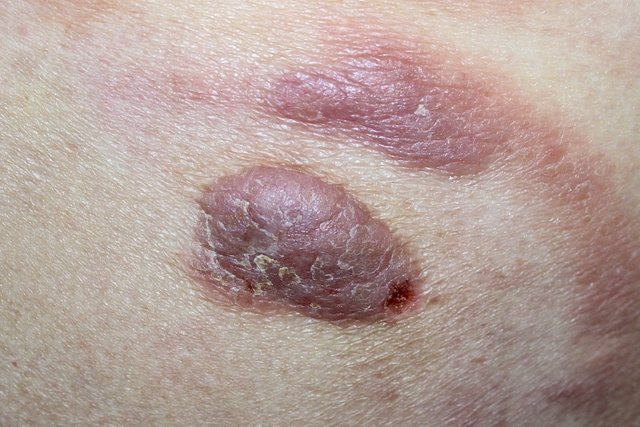
Symptoms of mycosis fungoides
The main symptoms of mycosis fungoides are:
- Red, pink or brownish spots on the skin;
- Peeling of the skin;
- Itch;
- Dry skin;
- Thinning of the skin in the affected region;
- Horseshoe-shaped, round or oval plaques on the skin, with raised and well-defined edges;
- Purplish-red plaques on the skin;
- Nodules or lumps on the skin, similar to mushrooms;
- Open wounds on the skin, which can become infected.
The spots on the skin can be single or multiple, and can appear especially on the lower part of the abdomen, buttocks, thighs and breasts, but can also affect the groin, armpits, elbow crease, face and scalp.
The symptoms of mycosis fungoides begin as an inflammatory process but soon turn into a cancerous process, which can spread to the lymph nodes or internal organs.
Therefore, it is important to consult a dermatologist whenever symptoms appear, so that the most appropriate treatment can be diagnosed and initiated.
Is mycosis fungoides contagious?
Despite its name, mycosis fungoides has nothing to do with fungi, having its name because the nodules on the skin resemble mushrooms, which are a type of fungus.
Therefore, mycosis fungoides is not contagious, not passing from one person to another, and is not treated with antifungals.
How to confirm the diagnosis
The diagnosis of mycosis fungoides is made by a dermatologist or hematologist through the evaluation of symptoms, health history, physical examination of the skin, and blood tests, such as complete blood count, liver function tests, lactate dehydrogenase levels, for example, to evaluate blood cells and whether there is an increase in the number of leukocytes or anemia.
Another blood test that may be requested by the doctor is the T lymphocyte gene rearrangement (TCR) test, in order to evaluate the proliferation of T lymphocytes and confirm the diagnosis of mycosis fungoides.
In addition, the doctor must perform a biopsy of the skin lesion or lymph node to confirm the diagnosis and rule out other health conditions that may have similar symptoms, such as psoriasis, parapsoriasis, lichen planus or eczema, for example. See how the biopsy is done.
To monitor the evolution of the disease and assess whether the tumor has affected the lymph nodes, some tests may also be requested by the doctor, such as X-ray, ultrasound, computed tomography, fluorodeoxyglucose-PET or magnetic resonance imaging.
Possible causes
The exact cause of mycosis fungoides is not yet fully known, however, it is known that it occurs due to genetic changes or mutations in the DNA of white blood cells, especially T lymphocytes, forming abnormal cells that begin to multiply uncontrollably, and leave from the bloodstream to the skin, resulting in symptoms.
How the treatment is carried out
The treatment of mycosis fungoides varies according to the stage of the disease and must be carried out under the guidance of a dermatologist, hematologist or oncologist, with the aim of relieving symptoms, eliminating cancer cells from the skin and preventing the disease from progressing.
The main treatments that may be recommended by your doctor are:
- Ointments for topical usesuch as corticosteroids, imiquimod, mechlorethamine or bexarotene;
- Photodynamic therapysuch as phototherapy with psoralen (PUVA), UVB radiation or extracorporeal photopheresis (ECP);
- Radiotherapyin the case of small skin lesions;
- Chemotherapy;
- Immunotherapycom interferon;
- Target therapywith monoclonal antibodies, such as brentuximab vedotin or mogamulizumab;
- Histone deacetylase inhibitorssuch as vorinostat or romidepsin;
- Immunosuppressantssuch as lenalidomide.
Furthermore, in cases where mycosis fungoides is difficult to control, the doctor may also recommend treatment with hematopoietic stem cell transplantation. Find out how stem cell transplantation is performed.
Treatment of mycosis fungoides should be started as soon as possible, as it progresses quickly and treatment in more advanced stages is more difficult.

Sign up for our newsletter and stay up to date with exclusive news
that can transform your routine!
Warning: Undefined array key "title" in /home/storelat/public_html/wp-content/plugins/link-whisper-premium/templates/frontend/related-posts.php on line 12
Warning: Undefined array key "title_tag" in /home/storelat/public_html/wp-content/plugins/link-whisper-premium/templates/frontend/related-posts.php on line 13

